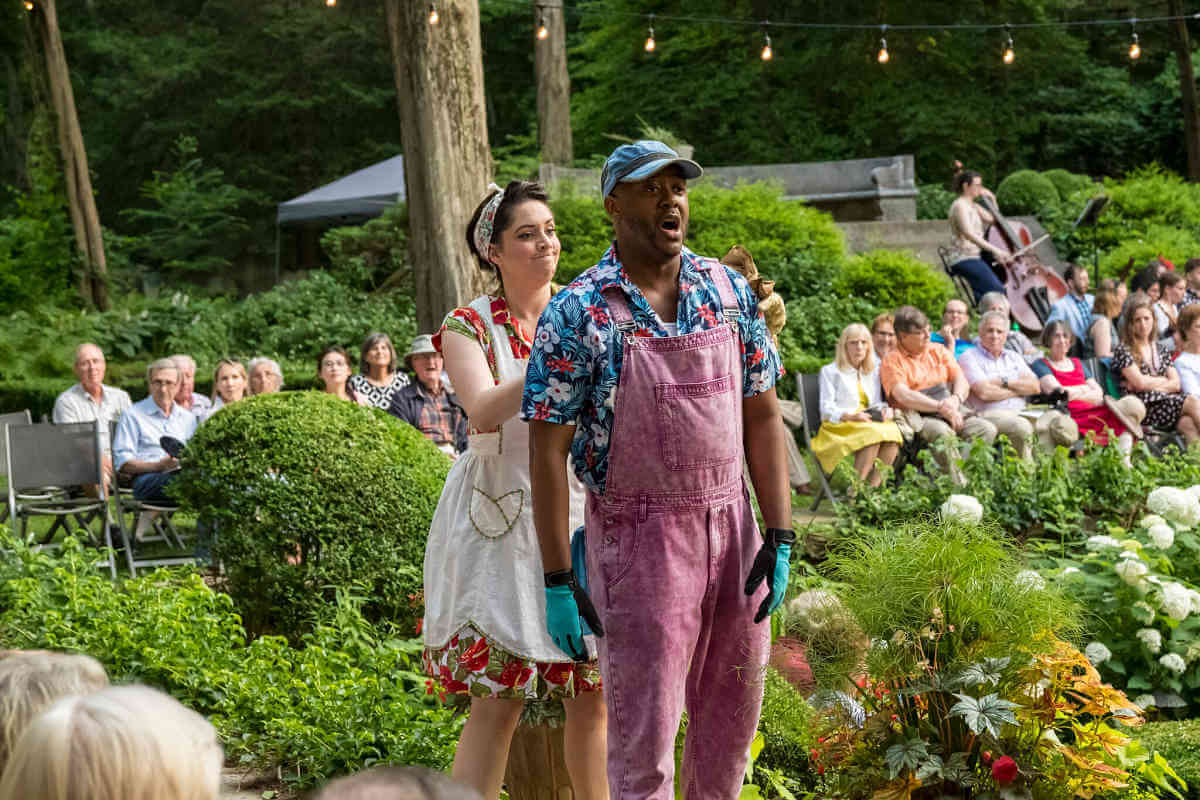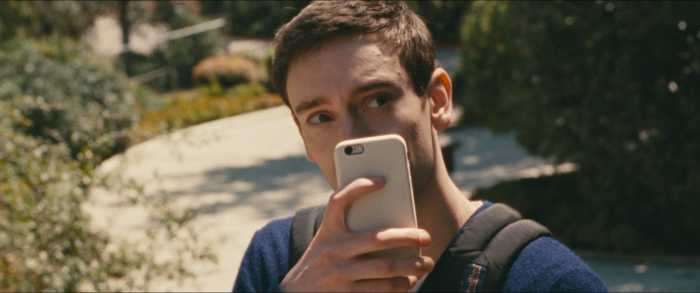When Will Crutchfield moved his “Bel Canto at Caramoor” program to SUNY Purchase as the “Teatro Nuovo” festival, Caramoor Festival artistic vice president Kathy Schuman turned to On Site Opera for a replacement operatic presentation.
Caramoor scheduled a revival of On Site Opera’s 2017 production of Mozart’s “The Secret Gardener” performed for one-night only on July 13. This English-language adaptation of Mozart’s youthful opera buffa “La Finta Giardiniera” (1775) premiered a year ago in May, staged outdoors in the West Side Community Garden on West 89th Street. Translator Kelley Rourke cut down Mozart’s original sprawling three-hour opera to just an hour and a half running time with new English spoken dialogue replacing the Italian recitatives.
At Caramoor, director Eric Einhorn ably restaged the production among the flower beds, sculptured hedges, and ornamental statuary of the Sunken Garden on the lushly landscaped grounds of the Rosen House in Katonah.
Mozart’s three act Italian opera premiered when the composer was just 18 and the absurd libretto (attributed to Calzabigi) concerns the romantic entanglements of seven would-be lovers. Much of Mozart’s music foreshadows his later collaborations with Da Ponte, and the characters are early sketches for their more famous counterparts in those mature masterworks: Sandrina is a precursor of Susanna and Pamina; her buffo baritone servant Nardo resembles Leporello and Figaro; the maid Serpetta is a cousin of Despina and Blondchen; the Mayor in his attempted seduction of his garden girl echoes Count Almaviva; the trouser role of Ramiro evokes Idamantes and Cherubino; and the haughty noble lady Arminda is one of Mozart’s “angry women,” mixing the vanity and confusion of Fiordiligi with the temperamental excesses of Donna Elvira, Vitellia, and Elettra.
The muddled libretto underlies the conventional opera buffa plot devices (“A loves B who loves C who is disguised as D, etc.”) with elements of dramma giocoso violence and madness. The mixture of comedy and tragedy looks forward to the dramatic ambiguity of “Così fan tutte,” “Don Giovanni,” and “Le Nozze di Figaro” but with a more conventional musical vocabulary. The Countess Violante (here “Lady Violet”), after surviving a violent quarrel with her unstable lover Belfiore, poses as Sandrina, a humble garden girl on the estate of the Mayor of Lagonero. Before the opera begins, the Count Belfiore stabbed Violante in a fit of jealous rage. Act II ends with Sandrina and Belfiore wandering in a wilderness where both simultaneously go mad and dance about distractedly.
On Site Opera’s streamlined edition shifts the emphasis to the comedy and romantic intrigue — perfect for a light summer entertainment. O’Rourke’s abridgement jettisoned the homicidal back story and the dual mad scenes — half of Sandrina’s mad scene provides a lucid lament while Belfiore’s delirium is played for comedy as a flight into romantic fancy. Rourke’s contemporary English dialogue dispenses occasional slangy sitcom jokes while the colloquial lyrics are clear and unpretentious but go flat with repetition.
Einhorn’s direction keeps the singers running around in circles (the opera is played with the audience seated on all four sides of the sunken garden), and he isn’t above staging crude visual jokes with bananas, garden shears, and water hoses. Beth Goldenberg’s fanciful contemporary costumes featured bright floral prints, witty use of accessories, and fun hats. The audience laughed at the high energy antics. None of the text that was jettisoned was on the level of a Da Ponte libretto, and the loss was offset by a gain in audience comprehension, dramatic concision, and clarity. Mozart’s youthful music shone brighter in a smaller framework.
The cast was young and energetic with some accomplished singing on the distaff side and characterful work from the men — the entire cast sang with dramatic point and commitment. Ashley Kerr’s dark hued lyric soprano brought out the inner confusion and emotional turmoil in Sandrina’s character – a few higher phrases would have benefited from a freer vocal production with more tonal float.
Emilie Savoy as the jealous, demanding Arminda also had a rich soprano timbre with a not inappropriate edge befitting her tempestuous character. Her angular soprano voice is filling out and maturing but has retained flexibility and an easy top.
Naturally expressive and intense, mezzo-soprano Kristin Gornstein’s mournful timbre with a tense quick vibrato captured the ardor and despair of Arminda’s rejected ex-lover Ramiro. Katrina Galka’s brightly sung Serpetta created a quirky, off-kilter character more interesting than the usual pert soubrette.
Spencer Viator’s plangent, warm-toned lyric tenor and puppyish ardor made the treacherous Count Belfiore more palatable on the stage than he is on the printed page. Tenor Michael Kuhn as the lecherous Mayor and baritone Jorell Williams as the bumbling servant Nardo sang and acted their purely comedic roles with such verve and uninhibited energy that occasional vocal lapses could be easily ignored.
Acoustics were compromised when the singers were facing away from sections of the audience but there was excellent ensemble and coordination. Musical director Geoffrey McDonald led the nine-piece Grand Harmonie ensemble in a beautifully lucid chamber reduction of Mozart’s score.
The audience vastly enjoyed the presentation on a perfect mild summer night. Caramoor will follow up the rare Mozart with a rare Handel opera in concert — “Atalanta” led by Nicholas McGegan on July 22.
In an online exclusive at gay-citynews.nyc, Eli Jacobson looks at three international coloratura sopranos the Met brought forward this spring in the title role of the Mary Zimmerman production of “Lucia di Lammermoor.”



































